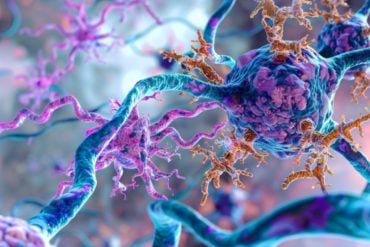Summary: Cognitive abnormalities associated with schizophrenia may be traced to altered activity in the thalamus during adolescence.
Source: Columbia University
A team of Columbia University researchers has reported new evidence that cognitive abnormalities seen in neuropsychiatric disorders such as schizophrenia may be traceable to altered activity in the thalamus during adolescence, a time window of heightened vulnerability for schizophrenia.
The research, published on May 19 in the journal Nature Neuroscience, holds promise for a more targeted therapeutic for schizophrenia and other brain disorders where cognitive dysfunction is related to altered prefrontal cortex function.
“Cognitive deficits are central to schizophrenia, but the underlying mechanisms still remain unclear,” said Christoph Kellendonk, Ph.D., associate professor in psychiatry and molecular pharmacology and therapeutics and senior author of the paper.
“This study puts emphasis on the thalamus and its importance during adolescence in regulating prefrontal cortex circuit maturation. We hope that our findings will inspire future studies to disentangle the influences of thalamic nuclei on the prefrontal cortex and cognitive control, paving the way for new treatment options.”
Brain abnormalities seen early
Schizophrenia, a disabling brain disorder characterized by delusional thinking and hallucinations, is typically diagnosed in young adults—with the average age of onset for men in the late teens to the early 20s and for women in the late 20s to early 30s. The abnormal developmental trajectory of the brain appears to be established during development, long before clinical symptoms of the disease appear in early adult life.
The prefrontal cortex—an area of the brain responsible for executive functions, such as planning, working memory, and impulse control—has long been implicated in the pathophysiology of schizophrenia. The thalamus is a structure in the middle of the brain that regulates prefrontal cortex function in the adult. However, its role during adolescent development is elusive.
To test how cortical development may go awry in the disease, Laura Benoit, first author and a MD, Ph.D. graduate student at Columbia, manipulated the activity of thalamic neurons in the brains of mice during adolescence and examined how it affected prefrontal cortex function later in life.
Rescuing cognitive impairment
The scientists discovered that thalamic inhibition during adolescence led to adult deficits in attentional set shifting—a form of cognitive flexibility that is impaired in individuals with schizophrenia. Strikingly, excitation of the thalamus during adulthood reversed the cognitive deficit in mice with developmentally altered cortical function.

“This shows that even in a developmentally altered brain, boosting thalamic function can still rescue cognitive impairments,” said Sarah Canetta, Ph.D., Assistant Professor in Psychiatry who co-led the study with Dr. Kellendonk and Alexander Harris, MD, Ph.D., Assistant Professor in Psychiatry.
“Our findings in the mouse suggest a neurodevelopmental framework in which the thalamus plays an important role in shaping the maturation of the prefrontal cortex. It has translational relevance, particularly for schizophrenia, and proposes a treatment strategy for enhancing cognition in humans.”
The study, “Adolescent thalamic inhibition leads to long-lasting impairments in schizophrenia,” was conducted in collaboration with the Center for Theoretical Neuroscience at Columbia’s Zuckerman Mind Brain Behavior Institute. Stefano Fusi, Ph.D., professor of neuroscience and principal investigator, and Lorenzo Posani, a postdoctoral research scientist, contributed to the research.
About this schizophrenia research news
Author: Press Office
Source: Columbia University
Contact: Press Office – Columbia University
Image: The image is in the public domain
Original Research: Closed access.
“Adolescent thalamic inhibition leads to long-lasting impairments in prefrontal cortex function” by Laura J. Benoit et al. Nature Neuroscience
Abstract
Adolescent thalamic inhibition leads to long-lasting impairments in prefrontal cortex function
Impaired cortical maturation is a postulated mechanism in the etiology of neurodevelopmental disorders, including schizophrenia.
In the sensory cortex, activity relayed by the thalamus during a postnatal sensitive period is essential for proper cortical maturation. Whether thalamic activity also shapes prefrontal cortical maturation is unknown.
We show that inhibiting the mediodorsal and midline thalamus in mice during adolescence leads to a long-lasting decrease in thalamo–prefrontal projection density and reduced excitatory drive to prefrontal neurons. It also caused prefrontal-dependent cognitive deficits during adulthood associated with disrupted prefrontal cross-correlations and task outcome encoding.
Thalamic inhibition during adulthood had no long-lasting consequences. Exciting the thalamus in adulthood during a cognitive task rescued prefrontal cross-correlations, task outcome encoding and cognitive deficits. These data point to adolescence as a sensitive window of thalamocortical circuit maturation.
Furthermore, by supporting prefrontal network activity, boosting thalamic activity provides a potential therapeutic strategy for rescuing cognitive deficits in neurodevelopmental disorders.






